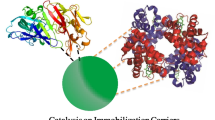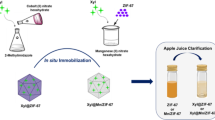Abstract
Acrylamidase produced by Cupriavidus oxalaticus ICTDB921 was recovered directly from the fermentation broth by ammonium sulfate (40–50%) precipitation and then stabilized by cross-linking with glutaraldehyde. The optimum conditions for the preparation of cross-linked enzyme aggregates of acrylamidase (acrylamidase-CLEAs) were using 60 mM glutaraldehyde for 10 min at 35 °C and initial broth pH of 7.0. Acrylamidase-CLEAs were characterized by SDS-PAGE, FTIR, particle size analyzer and SEM. Cross-linking shifted the optimal temperature and pH from 70 to 50 °C and 5–7 to 6–8, respectively. It also altered the secondary structure fractions, pH and thermal stability along with the kinetic constants, Km and Vmax, respectively. A complete degradation of acrylamide ~ 1.75 g/L in industrial wastewater was achieved after 60 min in a batch process under optimum operating conditions, and the kinetics was best represented by Edward model (R2 = 0.70). Acrylamidase-CLEAs retained ~ 40% of its initial activity after three cycles for both pure acrylamide and industrial wastewater, and were stable for 15 days at 4 °C, retaining ~ 25% of its original activity.
Article highlights
-
Acrylamidase from broth was recovered as cross linked enzyme aggregates (CLEAs)
-
Acrylamidase-CLEAs retained good kinetic and pH/thermal stability
-
Acrylamidase-CLEAs possessed good storage stability and reusability
-
Acrylamidase-CLEAs efficiently degraded acrylamide from industrial waste water






Similar content being viewed by others
References
World Health Organization (1985) Environmental Health Criteria 1985, 49, 1. International programme on chemical safety web. https://www.inchem.org/documents/ehc/ehc/ehc49.htm/. Accessed 9 July 2018
Scott JP, Fawell PD, Ralph DE, Farrow JB (1996) The shear degradation of high molecular-weight flocculant solutions. J Appl Polym Sci 62:2097–2106. https://doi.org/10.1002/(SICI)1097-4628(19961219)62:12%3c2097:AID-APP12%3e3.0.CO;2-3
Kurenkov VF, Hartan HG, Lobanov FI (2002) Application of polyacrylamide flocculants for water treatment. Chemistry and computational simulations. Butlerov Commun 3:31–40
Weideborg M, Kallqvist T, Odegard KE, Sverdrup LE, Vik EA (2001) Environmental risk assessment of acrylamide and methyloacrylamide from a grouting agent used in the tunnel construction of romeriksporten Norway. Water Res 35:2645–2652. https://doi.org/10.1016/S0043-1354(00)00550-9
Gao ZC, Lin YL, Xu B, Pan Y, Xia SJ, Gao NY, Zhang TY, Chen M (2017) Degradation of acrylamide by the UV/chlorine advanced oxidation process. Chemosphere 187:268–276. https://doi.org/10.1016/j.chemosphere.2017.08.085
Brown L, Bancroft KCC, Rhead MM (1980) Laboratory studies on the adsorption of acrylamide monomer by sludge, sediments, clays, peat and synthetic resins. Water Res 14(7):779–781. https://doi.org/10.1016/0043-1354(80)90255-9
National Science Foundation (1988) Drinking water treatment chemicals health effects. National Sanitation Foundation, Ann Arbor, p 60
Kitahara Y, Okuyama K, Ozawa K, Suga T, Takahashi S, Fujii T (2012) Thermal decomposition of acrylamide from polyacrylamide. J Therm Anal Calor 110(1):423–429. https://doi.org/10.1007/s10973-012-2544-7
Chu W, Gao N, Yin D, Krasner SW, Templeton MR (2012) Trace determination of 13 haloacetamides in drinking water using liquid chromatography triple quadrupole mass spectrometry with atmospheric pressure chemical ionization. J Chromatogr A 1235:178–181. https://doi.org/10.1016/j.chroma.2012.02.074
Bedade DK, Singhal RS (2018) Biodegradation of acrylamide by a novel isolate, Cupriavidus oxalaticus ICTDB921: identification and characterization of the acrylamidase produced. Bioresour Technol 261:122–132. https://doi.org/10.1016/j.biortech.2018.04.012
Cha M, Chambliss GH (2013) Cloning and sequence analysis of the heat-stable acrylamidase from a newly isolated thermophilic bacterium, Geobacillus thermoglucosidasius AUT-01. Biodegradation 24(1):57–67. https://doi.org/10.1007/s10532-012-9557-6
Shukor MY, Gusmanizar N, Ramli J, Shamaan NA, MacCormack WP, Syed MA (2009) Isolation and characterization of an acrylamide-degrading Antarctic bacterium. J Environ Biol 30(1):107–112
Ladole MR, Muley AB, Patil ID, Talib MI, Parate VR (2014) Immobilization of tropizyme-P on amino-functionalized magnetic nanoparticles for fruit juice clarification. J Biochem Technol 5(4):838–845
Muley AB, Chaudhari SA, Bankar SB, Singhal RS (2019) Stabilization of cutinase by covalent attachment on magnetic nanoparticles and improvement of its catalytic activity by ultrasonication. Ultrason Sonochem 55:174–185. https://doi.org/10.1016/j.ultsonch.2019.02.019
Brady D, Jordaan J (2009) Advances in enzyme immobilisation. Biotechnol Lett 31(11):1639. https://doi.org/10.1007/s10529-009-0076-4
Sheldon RA (2019) CLEAs, Combi-CLEAs and ‘Smart’Magnetic CLEAs: biocatalysis in a bio-based economy. Catalysts 9(3):261. https://doi.org/10.3390/catal9030261
Cui JD, Jia SR (2015) Optimization protocols and improved strategies of cross-linked enzyme aggregates technology: current development and future challenges. Crit Rev Biotechnol 35(1):15–28. https://doi.org/10.3109/07388551.2013.795516
Cui JD, Zhao YM, Li HB, Feng YX, Lin T, Zhong CH, Tan ZHL, Jia SR (2017) Encapsulation of spherical cross-linked phenylalanine ammonia lyase aggregates in mesoporous biosilica. J Agric Food Chem 65:618–625. https://doi.org/10.1021/acs.jafc.6b05003
Cui JD, Cui LIL, Jia SR, Su ZhG, Zhang SP (2016) Hybird cross-linked lipase aggregates with magnetic nanoparticles: a robust and recyclable biocatalysis for epoxidation of oleic acid. J Agric Food Chem 64(38):7179–7187. https://doi.org/10.1021/acs.jafc.6b01939
Chaudhari SA, Singhal RS (2017) A strategic approach for direct recovery and stabilization of Fusarium sp. ICT SAC1 cutinase from solid state fermented broth by carrier free cross-linked enzyme aggregates. Int J Biol Macromol 98:610–621. https://doi.org/10.1016/j.ijbiomac.2017.02.033
Sheldon RA, van Pelt S (2013) Enzyme immobilisation in biocatalysis: why, what and how. Chem Soc Rev 42(15):6223–6235. https://doi.org/10.1039/c3cs60075k
Tükel SS, Hürrem F, Yildirim D, Alptekin O (2013) Preparation of crosslinked enzyme aggregates (CLEA) of catalase and its characterization. J Mol Catal B Enzym 97:252–257. https://doi.org/10.1016/j.molcatb.2013.09.007
Li B, Dong S, Xie X, Xu Z, Li L (2012) Preparation and properties of cross-linked enzyme aggregates of cellulase. Adv Mater Res 581–582:257–260. https://doi.org/10.4028/www.scientific.net/AMR.581-582.257
Khanahmadi S, Yusof F, Amid A, Mahmod SS, Mahat MK (2015) Optimized preparation and characterization of CLEA-lipase from cocoa pod husk. J Biotechnol 202:153–161. https://doi.org/10.1016/j.jbiotec.2014.11.015
Nadar SS, Muley AB, Ladole MR, Joshi PU (2016) Macromolecular cross-linked enzyme aggregates (M-CLEAs) of α-amylase. Int J Biol Macromol 84:69–78. https://doi.org/10.1016/j.ijbiomac.2015.11.082
Sheldon RA (2011) Cross-linked enzyme aggregates as industrial biocatalysts. Org Process Res Dev 15:213–223. https://doi.org/10.1021/op100289
Cui JD, Li LL, Zhao YM (2014) Simple technique for preparing stable and recyclable cross-linked enzyme aggregates with crude-pored microspherical silica core. Ind Eng Chem Res 53(42):16176–16182. https://doi.org/10.1021/ie5021206
Bedade DB, Singhal RS (2017) Isolation and characterization of acrylamidase from arthrobacter sp. DBV1 and its ability to biodegrade acrylamide. Appl Biochem Biotechnol 182(2):570–585. https://doi.org/10.1007/s12010-016-2345-8
Bedade DB, Sutar YB, Singhal RS (2017) Chitosan coated calcium alginate beads for covalent immobilization of acrylamidase: process parameters and removal of acrylamide from coffee. Food Chem 275:95–104. https://doi.org/10.1016/j.foodchem.2018.09.090
Nawaz M, Khan A, Bhattacharya D, Sittoneu P, Cerniglia C (1996) Physical, biochemical, and immunological characterization of a thermostable amidase from Klebsiella pneumoniae NCTR 1. J Bacteriol 178:2397–2401
Bradford MM (1976) A rapid and sensitive method for the quantitation of microgram quantities of protein utilizing the principle of protein-dye binding. Analyt Biochem 72(1–2):248–254. https://doi.org/10.1016/0003-2697(76)90527-3
Muley AB, Chaudhari SA, Singhal RS (2017) Non-covalent conjugation of cutinase from Fusarium sp. ICT SAC1 with pectin for enhanced stability: process minutiae, kinetics, thermodynamics and structural study. Int J Biol Macromol 102:729–740. https://doi.org/10.1016/j.ijbiomac.2017.04.072
Muley AB, Chaudhari SA, Mulchandani KH, Singhal RS (2018) Extraction and characterization of chitosan from prawn shell waste and its conjugation with cutinase for enhanced thermo-stability. Int J Biol Macromol 111:1047–1058. https://doi.org/10.1016/j.ijbiomac.2018.01.115
He F (2011) Laemmli-SDS-PAGE. Bio-protocol Bio101:80. https://doi.org/10.21769/BioProtoc.80
Muley AB, Thorat AS, Singhal RS, Babu KH (2018) A tri-enzyme co-immobilized magnetic complex: process details, kinetics, thermodynamics and applications. Int J Biol Macromol 118:1781–1795. https://doi.org/10.1016/j.ijbiomac.2018.07.022
Xu MQ, Wang SS, Li LN, Gao J, Zhang YW (2018) Combined cross-linked enzyme aggregates as biocatalysts. Catalysts 8(10):460. https://doi.org/10.3390/catal8100460
Fazary AE, Ismadji S, Ju YH (2009) Biochemical studies on native and cross-linked aggregates of Aspergillus awamori feruloyl esterase. Int J Biol Macromol 44(3):240–248. https://doi.org/10.1016/j.ijbiomac.2008.12.012
Talekar S, Pandharbale A, Ladole M, Nadar S, Mulla M, Japhalekar K, Pattankude K, Arage D (2013) Carrier free co-immobilization of alpha amylase, glucoamylase and pullulanase as combined cross-linked enzyme aggregates (combi-CLEAs): A tri-enzyme biocatalyst with one pot starch hydrolytic activity. Bioresour Technol 147:269–275. https://doi.org/10.1016/j.biortech.2013.08.035
Gupta K, Jana AK, Kumar S, Jana MM (2015) Solid state fermentation with recovery of amyloglucosidase from extract by direct immobilization in cross linked enzyme aggregate for starch hydrolysis. Biocatal Agric Biotechnol 4:486–492. https://doi.org/10.1016/j.bcab.2015.07.007
Agyei D, He L (2015) Evaluation of cross-linked enzyme aggregates of Lactobacillus cell-envelope proteinases, for protein degradation. Food Bioprod Process 94:59–69. https://doi.org/10.1016/j.fbp.2015.01.004
Yamaguchi H, Kiyota Y, Miyazaki M (2018) Techniques for preparation of cross-linked enzyme aggregates and their applications in bioconversions. Catalysts 8(5):174. https://doi.org/10.3390/catal8050174
Bedade DK, Muley AB, Singhal RS (2019) Magnetic cross-linked enzyme aggregates of acrylamidase from Cupriavidus oxalaticus ICTDB921 for biodegradation of acrylamide from industrial waste water. Bioresour Technol 272:137–145. https://doi.org/10.1016/j.biortech.2018.10.015
Panwar D, Kaira GS, Kapoor M (2017) Cross-linked enzyme aggregates (CLEAs) and magnetic nanocomposite grafted CLEAs of GH26 endo-β-1,4-mannanase: improved activity, stability and reusability. Int J Biol Macromol 105:1289–1299. https://doi.org/10.1016/j.ijbiomac.2017.07.154
Cui JD, Zhao YM, Zhong C, Tan ZL, Han PP, Jia SR (2017) Mesoporous phenylalanine ammonia lyase microspheres with improved stability through calcium carbonate templating. Int J Biol Macromol 98:887–896. https://doi.org/10.1016/j.ijbiomac.2017.02.059
Samoylova Y, Sorokina K, Piligaev A, Parmon V (2018) Preparation of stable cross-linked enzyme aggregates (CLEAs) of a Ureibacillus thermosphaericus esterase for application in malathion removal from wastewater. Catalysts 8(4):154. https://doi.org/10.3390/catal8040154
Lai JQ, Hu ZL, Sheldon RA, Yang Z (2012) Catalytic performance of cross-linked enzyme aggregates of Penicillium expansum lipase and their use as catalyst for biodiesel production. Proc Biochem 47(12):2058–2063. https://doi.org/10.1016/j.procbio.2012.07.024
Mafra ACO, Koppa W, Beltrameb MB, Giordanoa RLC, Ribeirob MPA, Tardiolia PW (2016) Diffusion effects of bovine serum albumin on cross-linked aggregates of catalase. J Mol Catal B Enzym 133:107–116. https://doi.org/10.1016/j.molcatb.2016.08.002
Mayaux J, Cerbelaud E, Soubrier F, Yeh P, Blanche F, Petre D (1991) Purification, cloning and primary structure of a new enantioselective amidase from a Rhodococcus strain: structural evidence for a conserved genetic coupling with nitrile hydratase. J Bacteriol 173:6694–6704
Schoevaart R, Wolbers MW, Golubovic M, Ottens M, Kieboom APG, Van Rantwijk F, Van der Wielen LAM, Sheldon RA (2004) Preparation, optimization, and structures of cross-linked enzyme aggregates (CLEAs). Biotechnol Bioeng 87(6):754–762. https://doi.org/10.1002/bit.20184
Prabu CS, Thatheyus AJ (2007) Biodegradation of acrylamide employing free and immobilized cells of Pseudomonas aeruginosa. Int Biodeterior Biodegrad 60:69–73. https://doi.org/10.1016/j.ibiod.2006.11.007
Acknowledgements
The authors would like to thank the Department of Biotechnology, Ministry of Science and Technology, Government of India, New Delhi, for providing the financial supports to carry out this research work.
Author information
Authors and Affiliations
Corresponding author
Ethics declarations
Conflict of interest
The authors declare that they have no conflict of interest in this research.
Ethical approval
This article does not include any studies with human participants or animals performed by any authors.
Additional information
Publisher's Note
Springer Nature remains neutral with regard to jurisdictional claims in published maps and institutional affiliations.
Electronic supplementary material
Below is the link to the electronic supplementary material.
Rights and permissions
About this article
Cite this article
Kulkarni, N.H., Muley, A.B., Bedade, D.K. et al. Cross-linked enzyme aggregates of arylamidase from Cupriavidus oxalaticus ICTDB921: process optimization, characterization, and application for mitigation of acrylamide in industrial wastewater. Bioprocess Biosyst Eng 43, 457–471 (2020). https://doi.org/10.1007/s00449-019-02240-4
Received:
Accepted:
Published:
Issue Date:
DOI: https://doi.org/10.1007/s00449-019-02240-4




